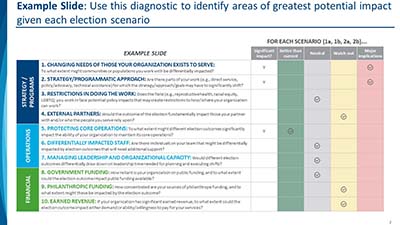Votes have been cast. Races from up and down the ballot have been decided. How will the election results affect your nonprofit, the communities you serve, the partners you work with, and the issue areas you work on?
While you can’t predict the future, you can increase your preparedness for any potential future through “scenario planning.”
This simple diagnostic tool (PowerPoint) can help you and other members of your team reflect on and discuss the potential impacts of the election results.

As we’ve shared in this article, which outlines a step-by-step approach, scenario planning can help navigate political uncertainty. Just like packing a “go bag” for an emergency, this can help your organization be more ready to continue to advance its mission regardless of what happens.
In response to nonprofit leaders’ concerns and questions about how the results of the elections could impact their work and organizations, we developed a simple diagnostic tool—a set of questions and potential actions you might take depending on how you answer. If you have suggestions for other resources you think might be helpful to other nonprofit leaders in this post-election environment, please fill out the form below.
10 Things to Consider as You Prepare for an Uncertain Future
Depending on where your organization operates and the type of work you do, election results could have small or large implications for your organization’s work. This PowerPoint diagnostic tool can help you think through which aspects of your work may be most impacted under different election results.
The below sections cover the three core areas from the diagnostic in detail: strategy/programs, operations, and funding. Under each we highlight key questions, considerations, and potential actions to help guide you in filling out the diagnostic and navigating next steps for your organization.
Strategy/Programs
1. Changing needs of the people your organization serves
To what extent might communities or populations you work with be differentially impacted by the election results?
Consider:
- How might the communities or populations you work with be impacted?
- How will the communities’ or populations’ needs and available supports be affected, in the short or longer term?
- What might that mean for the work your organization should focus on in the short or longer term?
Potential actions:
- Make a list of potential communications you may want to have ready to send if and when the time comes; for key communications, you could even write the first draft.
- Reach out to key partner organizations to understand how they might be mobilizing to support those most impacted.
2. Strategy/programmatic approach
Are there parts of your work (e.g., direct service, policy/advocacy, technical assistance) for which the strategy/approach/goals may have to significantly shift?
Consider:
- How, if at all, might your organization’s longer-term strategy and goals need to shift given changing needs (e.g., increased demand for services) or shifting external environment?
- If your organization engages in a mix of direct service and other efforts (e.g., technical assistance, advocacy), how much of your work (e.g., programs, services, activities) might need to significantly pivot?
- If your organization engages in advocacy or other systems-change efforts:
- How might your battlefields (e.g., state, municipal, federal levels) or progress indicators have to shift (e.g., hold ground versus make gains)?
- How might narrative change efforts have to shift?
- How might the election outcome shift whom you collaborate or ally with to enable progress on divisive issues?
Potential actions:
- Remind yourself and your team of your organization’s vision, mission, values, long-term goals, and theory of change.
- Clarify or develop guiding principles to use in your decision making.
- Create a portfolio of potential actions you might take, including both large shifts and smaller-scale, more flexible actions that can be tested, implemented, or reversed quickly.
- Focus on the most critical potential actions needed versus getting distracted or overwhelmed in trying to plan for everything.
3. Restrictions in doing the work
Does the field (e.g., reproductive health, racial equity, LGBTQ) you work in face potential policy impacts that may create restrictions to how/where your organization can work?
Consider:
- How might anticipated restrictions impact demand, ability to deliver quality programs/services, or location/modality of delivery?
- How might anticipated restrictions impact the cost of delivering services?
Potential actions:
- Identify and review any existing resources that have outlined potential policy impacts of different election outcomes for your field.
- Reach out to peer organizations in your field to collaborate and understand the proactive or reactive actions they are considering under different election outcomes.
4. External partners
Would there be an impact on those you partner with and/or those who the people you serve rely upon?
Consider:
- How might the election result impact priorities, strategies, or other aspects of your partnerships? Or the broader stakeholder landscape?
- To what extent are there actions you might take in solidarity with other organizations in your field or community? With whom?
Potential actions:
- Reach out to key partners to discuss the potential impacts they are considering and whether coordinated action could be beneficial.
- Refresh any stakeholder/relationship mapping that is critical to your work.
Operations
5. Protecting core operations
To what extent might there be an impact on your organization's ability to maintain its core operations?
Consider:
- Based on the location or nature of your organization’s work, could the safety/security of your staff be in jeopardy?
- To what extent is non-partisanship important to protecting your organization’s ability to be effective (e.g., advancing your mission, maintaining funding, talent, external relationships)?
Potential actions:
- Make sure your organization has emergency plans in place.
- Ensure there are clear decision rights (e.g., RAPID) within the leadership team to enable rapid response.
- Determine what organizational policies might need to be in place (e.g., time off for staff volunteering, policies regarding staff participation in political protests, including in person or on social media).
6. Differentially impacted staff
Are there individuals on your team who might be differentially impacted and who will need additional support?
Consider:
- Who may be most impacted, and how might they be impacted?
- To what extent could there be significantly diverging perspectives within your organization on election results?
- How will your organization communicate given your values and constraints?
- Where are you willing to draw lines in the sand about your organization’s stances on issues?
- What did you learn from managing through the aftermath of recent elections?
Potential actions:
- Create and have ready communications you may want to release; acknowledge the impact and offer support in these communications.
- Determine what norms, policies, and supports should be in place; test these options with staff members and other leaders.
- Reassess timelines for non-essential work, as people may not be as productive if there is significant upheaval.
7. Managing leadership and organizational capacity
Will this election outcome have a differential impact on leadership and the time they will need to plan for and execute shifts?
Consider:
- Based on the potential impacts you identified, are there particular leaders or staff within your organization who will be critical to engage in decision making about actions to take given the election results?
Potential actions:
- Reserve time for leadership to make decisions and support the organization if the election result has a significant impact on your organization.
- Establish formal or informal organizational linking mechanisms, such as cross-functional teams, to make it easier for staff to coordinate efforts and share knowledge.
Funding
8. Government funding
How reliant is your organization on public funding, and to what extent could the election result impact the public funding that is available?
Consider:
- How are your peer organizations, as well as organizations involved in policy/advocacy in this space, thinking about this? In what ways are they mobilizing?
- To what extent could the known risks to your public funding sources galvanize private funders to increase their support? Is there historical data on whether this happened when prior administrations took office, if there was a swing in federal or state funding priorities?
Potential actions:
- Assess funding streams and identify the level and type of impact on your organization’s activities if government funding amounts change; as needed, clarify possible actions to take.
- Determine how you might position the organization to access philanthropic funding to replace federal or state funding that could be at risk.
9. Philanthropic funding
How concentrated are your sources of philanthropic funding, and to what extent might these be impacted?
Consider:
- When you look at your organization’s sources of philanthropic revenue, which are committed, fairly certain, or at risk?
- Are there any scenarios in which you anticipate a potential influx of philanthropic funding given the issue area you work in? How can you be prepared to quickly mobilize additional funds in service of your mission?
Potential actions:
- Stay close to your funders, communicate about what you’re seeing and how you plan to respond; ask for transparency if they expect major shifts in funding priorities or payout levels.
- Free up as much funding as possible for your highest-priority activities; consider renegotiating guidelines on restricted grants.
- Design for rapid deployment of resources if you anticipate a potential influx of philanthropic funding to ensure funding gets to areas of emergency need (e.g., clarify purpose, decision rights, mechanisms for regranting).
10. Earned revenue
If your organization has significant earned revenue, to what extent might there be an impact either on demand or ability/willingness to pay for your services?
Consider:
- How might demand for your programs/services be impacted by the election results?
- How might ability/willingness to pay for programs/services shift? Are there opportunities to access third-party payers (e.g., philanthropy)?
Potential actions:
- Outline options for how your organization might pivot your offerings or approaches in the case of sharply increased or reduced demand and/or willingness to pay.
Additional Resources
2024 Election-Related Scenarios
- Axios’s “Behind the Curtain Series” shares detailed scenarios on “radically different Washington environments” that businesses and social sector organizations will face depending on the election’s outcome.
- Freedman Consulting, “Scenario Mapping & Philanthropic Levers for Impact: Planning for 2024.”
- Future Good's “Scenario Planning in Action” webinars explore scenario planning for potential Trump or Harris presidencies.
Strategy/Programs
- Bridgespan’s “Navigating Political Uncertainty: Scenario Planning for Nonprofits During This US Election Year” walks through how to build scenario plans for different futures during this election year.
- Bridgespan’s “A Compass for the Crisis: Nonprofit Decision Making in the COVID-19 Pandemic” provides a set of decision-making principles that can help nonprofits make challenging decisions quickly and navigate tough tradeoffs.
- Building Movement Project’s “The 2024 Elections and Beyond: Fortifying Ourselves, Our Organizations, and Our Ecosystems” toolkit offers worksheets targeted at movement-building organizations and activists.
- Democracy Forward’s guide breaks down the plans within Project 2025.
Operations
- The Management Center offers practical tips for nonprofit leaders and managers on getting “election ready.”
- In Bridgespan’s “Be the Calm in the Storm: How to Communicate with Staff and Stakeholders During a Crisis,” three Seattle nonprofit leaders describe how they've approached their communications in uncertain times.
- WithIn Collaborative’s “2024 Election Preparation Guide” supports leaders with tools for personal reflection.
- Bridgespan’s “The RAPID Decision-Making Tool for Nonprofits” provides an overview of a commonly used decision-making tool.
- In “Leading Through Crisis: A Conversation with the Man Who Led Limited Brands’ Response to 9/11,” Len Schlesinger provides guidance on leading through uncertain times.
- Nonprofit Quarterly’s “Defanging Disinformation: 6 Action Steps Nonprofits Can Take” offers tactical guidance for nonprofits to combat disinformation.
Funding
- Bridgespan’s “Eight Steps for Managing Through Tough Times” details specific steps for weathering uncertainty, including planning for contingencies and staying close to funders.
- Candid’s “Nonprofit fundraising in an election year is especially tough. What can fundraisers do?” provides tactical advice for nonprofit fundraising in an election year.
- CCS Fundraising’s “Charitable Giving During Presidential Elections” report shares data on philanthropy in election years.
- Bridgespan’s “Learning from Nonprofits and NGOs That Have Put Large, Flexible Grants to Work” could be helpful if your organization receives an influx of philanthropic funding following the election (as happened to some in 2016 and 2020).



